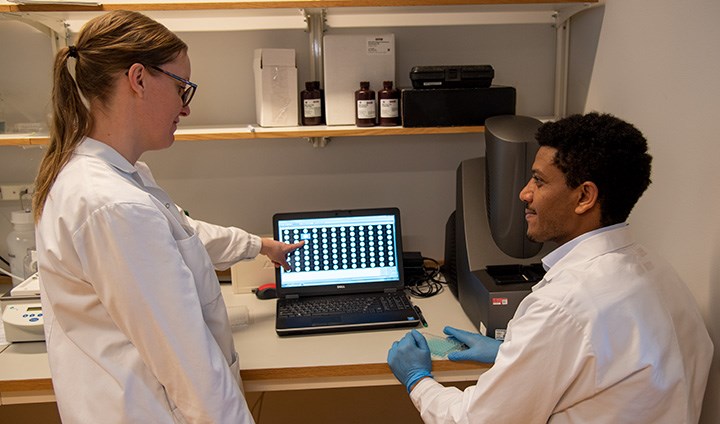Heart attack in smokers – warning signs in blood several years prior

With the help of frozen blood samples, researcher Mulugeta Zegeye has been able to study how smokers and people with high blood pressure suffer heart attacks. He has detected warning signs in the blood as far back as seven years prior to the heart attack.
A new cause of heart attack in smokers and people with high blood pressure has been discovered.
Scientists at Örebro University have studied a new biomarker, which can be found in the blood years before the actual heart attack.
“It’s a very strong predictor of future myocardial infarction,” says researcher Liza Ljungberg.
In freezers in the north of Sweden, a large number of blood plasma samples are stored at a temperature of -80°C. Since the mid-1980s, thousands of blood samples and data have been collected from volunteers in the region. Researchers have been able to follow these people over time to see if they develop different types of diseases, particularly focusing on cardiovascular disease. The frozen storage keeps the samples intact for a long time.
Scientists at Örebro University have now studied a small component in these blood samples, the inflammation marker Interleukin-6, IL-6, in a different way than before.
In this new study, samples from almost 300 people who later in life have suffered a heart attack – or myocardial infarction – were compared to as big a control group. It turned out that the levels of a new biomarker were heightened – already several years prior to the heart attack. In some, a heightened level of the biomarker was detected as much as seven years before they were taken ill.
“We discovered that this biomarker could predict what was going to happen,” says Mulugeta Zegeye, researcher at Örebro University.

A good side and a bad
In the new study, presented in the scientific journal Atherosclerosis, Thrombosis and Vascular Biology, IL-6 has been examined in a novel fashion. IL-6 is part of the body’s immune system and is produced whenever there is acute or chronic inflammation. It is, for instance, one of the things that causes a fever.
But IL-6 also affects other bodily functions and does have both a good side and a bad. Previous studies have shown that it can both prevent and cause inflammation.
“What’s unique about this study is that we’ve only studied the inflammatory aspects of IL-6. We have measured the levels of inflammatory IL-6 in the blood,” says Mulugeta Zegeye.
By only focusing on its inflammatory function, the scientists have been able to show that for two major risk groups, IL-6 is often key for heart attacks occurring. For smokers and people with high blood pressure, their lifestyle is not always the direct cause of the heart attack. Instead, it is sometimes caused by the body reacting in different ways to the smoking or the high blood pressure.
The study indicates that the levels of inflammatory IL-6 increase when smoking or high blood pressure is involved. The inflammatory element of IL-6 therefore works as a bridge, leading up to the heart attack.
“This is a very novel finding,” says Mulugeta Zegeye.
Benefits patients
The new biomarker can make it possible to measure if patients by making changes to their lifestyle at the same time can reduce the risk of suffering a heart attack. By monitoring patients lowering their blood pressure or giving up smoking, it will be possible to see if the levels of inflammatory IL-6 decrease.
The study also provides a new understanding of the mechanisms involved when common risk factors, such as smoking and high blood pressure, lead to a heart attack. This knowledge is important for the treatment and prevention of the disease in the future.
Heightened levels of inflammatory IL-6 is just a part of the explanation as to why those included in the study got ill. To get the full picture, many other links also need investigating. With that said, this new biomarker accounts for between 15 and 30 per cent of the risk of heart attack in smokers or people with high blood pressure.
“It’s a lot, given that we only used one biomarker. So in the future, we plan to include other biomarkers to explain the relationship with other risk factors and cardiac malfunction,” says Mulugeta Zegeye.

Chief cause of death globally
Cardiovascular disease is today the most common cause of death in the world, accounting for almost one in three deaths.
According to the World Health Organisation, WHO, 17.9 million people die each year as a result of cardiovascular disease. Stroke and myocardial infarction cause the most deaths. There is a number of known risk factors that increase the risk of cardiovascular disease, such as sex, age, diabetes, high blood pressure, smoking and being overweight. In many cases, these factors do not affect the heart directly but rather have an indirect impact in various ways.
As yet, there are no approved drugs that specifically block the inflammatory effects of IL-6, but clinical studies linked to several different diseases are underway.
“Focusing on solely reducing the inflammatory characteristics of IL-6 could reduce inflammation without other important functions in the body being impaired. This means that serious side effects of the medication can be avoided,” says Liza Ljungberg.
Text and photo: Jesper Mattsson
Translation: Charlotta Hambre-Knight
